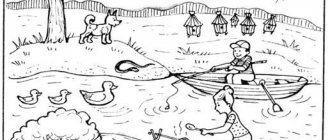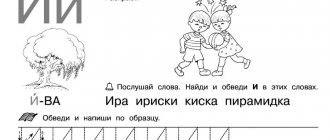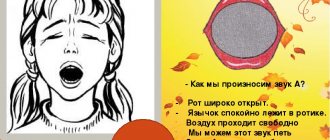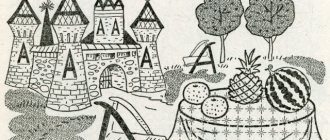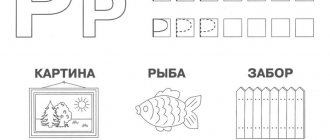Homework for the sound L for parents is developed comprehensively and contains numerous games and exercises. You can download these lessons from our website in one file (see below).
These are 20 lessons with various tasks:
- articulatory gymnastics for the sound “L”;
- automation in syllables, words, phrases, sentences, texts, poems;
- retelling and composing stories based on mnemonics and plot pictures;
- learning funny poems;
- repetition and memorization of pure phrases;
- interesting tasks on adventure games, coloring books, games and exercises based on our website logoped-online.by
Each lesson is located on 2 sheets of A4 format. You can print on two sheets, or on one - a page on each side. Total, 20 sheets - 20 full-fledged lessons for practicing the sound “L”.
The classes are developed based on our website logoped-online.by . On the site you will find colorful illustrations, mnemonic tracks, games and exercises to help with the printouts.
Instructions included.
Each lesson contains a set of articulation exercises for the sound “L”. At the beginning, all exercises are presented in pictures and with descriptions. Further descriptions are attached only to new exercises. Articulatory gymnastics exercises are necessary to prepare the speech apparatus, so do them. And your baby will speak faster!
In each lesson you will also find a lot of varied speech material . Pictures of the speech material can be found using the provided links or QR codes. You can log in from your smartphone using a special application. By following links or codes you get to the site and complete the same tasks, but with the help of pictures. All this is done in order to make classes as interesting and comfortable as possible for kids.
In order for the child to find it both interesting and at the same time useful, the classes are supplemented with numerous coloring pages . This is both visibility for the child and the development of fine motor skills of the fingers. Let us remind you that it is better to color with triangular pencils: they fit better in the child’s fingers.
And the main rule is to make sure that the child says the sound “L” correctly!!!
The website presents an abbreviated version of a set of lessons on strengthening the sound “L”. You can get the full version by writing to the email address
Topic: “Sound [L]. Letter L"
Target:
- Introduce the sound [L] and the letter L.
Tasks:
Correctional and educational:
- clarification of the articulation of sound [L];
- development of phonemic hearing and perception;
- identifying a given sound by ear;
- compilation of sound characteristics;
- determining the location of sound in words;
- the use in speech of complex sentences with the meaning of opposition;
- the use of prepositional constructions of the instrumental case in speech; sound-letter analysis of the word “lama”;
- acquaintance with the letter L;
- learn to listen carefully to an adult’s speech, correctly understand logical and grammatical structures and answer questions;
Correctional and developmental:
- develop phonemic perception, visual attention, memory, thinking;
Correctional and educational:
- develop independence, perseverance, and the ability to work in a team.
Equipment:
- subject pictures; letter boxes, blue pencils, charts for reading syllables.
Progress of the lesson
Organizing time
Children stand near the speech therapist.
Speech therapist: Today I have prepared riddles for you, listen carefully, whoever guesses raises his hand. I will open the pictures of the answer on the board.
Puzzles
An angry grandfather sits in the ground. Dressed in a yellow fur coat, Whoever undresses him sheds tears. (ONION)
Lights up the way at night, doesn't let the stars sleep. Let everyone sleep, she has no time for sleep, There is light in the sky for us... (MOON)
Who is wearing a bright red beret, In a black satin cap? He doesn't look at me, He keeps knocking, knocking, knocking (WOODPECKER)
Four legs, seat and back. We are not horses, although everyone sits on us many times. (CHAIR)
I am the most energetic worker in the workshop, I beat as hard as I can all day long. (HAMMER)
It slips away like something alive, but I won’t let it go. It foams with white foam, I’m not too lazy to wash my hands. (SOAP)
L: Well done, and now I’ll say the guess words again, and I’ll highlight one sound with my voice. You should guess which sound I highlighted.
- Bow, moon, shovel, chair, hammer, soap.
Children - sound [L].
I. Introducing the sound [L]
1. Sound characteristics.
Speech therapist - listen to how this sound sounds - [l,,,l,,,l]. Now this sound will be uttered by Masha, Varya...
Tell me what sound it is - consonant, hard. Why did you decide so? (can’t sing, teeth and tongue get in the way)
L - that's right, now cover your ears with your palms and say the sound again. What else can you say about the sound [l]?
Children - he is loud.
L - if the sound is consonant, hard, then what sound symbol will we use to denote it?
D - blue circle.
2. L - and now let’s play the game “ Find the place of the sound in the word ” (using the guessing pictures) - name an object where the sound [L] is at the beginning of the word, in the middle of the word, at the end of the word. (There are diagrams on the board above words, and children post pictures under them)
Children line up in a circle.
3. L- Let's play the game “ Repeat without a mistake .” Development of phonemic hearing, pronunciation of syllable chains with vowel replacement (lo-lu-la...)
The children sit at the tables.
4. L - there are two pictures in front of you.
Didactic exercise “Find the difference”
Children compare objects: “In the first picture there is a boat, but in the second picture there is no boat.”
Didactic exercise “Find a place”
L - between what objects is the shovel located?
D - the shovel is located between the bow and the boat.
Physical education minute
(performing movements while speaking the text)
The flat boat floated; there were two oars in the boat. And the frogs on the oars swam merrily somewhere.
II. Introducing the letter L
L - what does the letter L look like?
Guess, look. Maybe it's a tick - Consists of sticks. The corner is the exact form, the letter stands exactly like this.
1. L - children, remind us how a sound differs from a letter!
(D - we hear and pronounce sounds, but we see and write the letter).
L - the letter L can be capitalized or small. Why is a capital letter needed?-
D - to write first name, last name, animal names, city name...
2. Reading reverse and forward syllables according to patterns . Reading syllables with a confluence (sla, slo, slu, sly, shla, shlo, shlu, shly)
3. Work at the cash registers.
L - you have the letters L on your tables, capital and small. Open the cash registers and move new residents into your apartment.
On the board there is a picture with the animal LAMA.
Laying out the word at the box office - LAMA, sound analysis of the word. Dividing a word into syllables.
L - how many sounds are in the first syllable, name the first syllable. How many sounds are in the second syllable, name the second syllable.
Laying out the syllabic pattern
Finger gymnastics “Here are the needles and pins”
striped stick
Vladik walked with Polkan and constantly threw a stick at him. Polkan did not want to carry a stick. Then Vladik himself began to run after the stick. He knelt down, picked up a stick from the ground with his teeth and carried it to Polkan. Yes, studying was hard!
Once Vladik threw the stick especially far. Polkan was not seen for a long time. Finally, Vladik noticed that Polkan was carrying a stick in his teeth. The owner smiled contentedly. When Polkan came closer, Vlad saw in his mouth... a striped police baton!
Fun party
The last day of the year has arrived. Lyudmila was waiting for guests for dinner. How many things does a young housewife need to do?
First, she ran to the store, then washed all the dishes. Lyudmila installed a Christmas tree in the corner of the room and hung light bulbs on it.
“Just to make it in time for dinner!” - flashed through her head. Lyudmila baked a turkey in the oven, made several salads, and then put sweets and apples in a vase. All that remained was to put on a new dress.
The tired housewife lay down on the sofa for a minute... Lyudmila did not hear the calls.
When the New Year arrived, she slept soundly!
Reasons for incorrect pronunciation
Pronunciation may be incorrect or unformed because:
- the child is still too small to pronounce, simply skips the phoneme, says not “fox”, but “isa” (mastering the sound “L” occurs at about 4 years, recognition of hardness and softness – at 6 years);
- the tongue is placed incorrectly (interdental pronunciation is clear, but distorted);
- the tongue is lowered (bilabial pronunciation is typical for the English, often observed in children raised in interethnic families);
- the tongue is relaxed, and the lower lip actively moves ("B" appears).
In the cases described above, articulation is impaired due to a defect in the position of the tongue in the mouth. Also, a pronunciation defect is a consequence of the fact that a distorted air flow is formed due to the incorrect position of the end or middle of the tongue:
- the lips move when producing sound, not the tongue;
- the end of the speech organ descends rather than rests on the upper incisors;
- the middle of the tongue bends upward, and the end drops (normally it should be the other way around).
To correct the described defects of the articulatory apparatus, several sessions with a speech therapist are sufficient. But if the cause of distorted pronunciation is dysarthria caused by pathologies of the nervous system, then a systemic and multi-stage correction is required.
It's a pity!
It was summer. Volodya’s mother left home on business. She left her son some money and told him to go to the store. Volodya had to buy two packages of milk, two packs of butter and a package of sour cream.
Volodya took his bag and went to the store. He bought butter, sour cream and milk. When Volodya entered the entrance, the boys he knew called out to him: “Volodya, come out, let’s play football!”
Volodya flew into the kitchen, threw his bag on the floor and immediately ran out into the street. After half an hour in a warm place, without a refrigerator, the milk turned sour, the butter began to flow, and the sour cream became liquid and tasteless.
What a pity!
The feasibility of speech therapy classes
Some parents do not think about how to teach their child to say the letter L. They do not consider the defect to be something serious, but in adult life it will become the basis of complexes and worries.
Important! It is better to correct speech disorders in preschool age, then the process will take a little time.
How to make a lapbook for speech development with your own hands in a preschool educational institution
If parents do not know how to correctly teach their child to pronounce the letters L and R, then they should contact a specialist. A speech therapist will be able to correct this problem and develop the desired pronunciation.
How many lessons does it take to produce sound [l]
It is impossible to say with certainty how many lessons will be required to eliminate the defect. Sometimes sound production takes one session, in other situations it will take more than 30-40 meetings.
It all depends on the characteristics of the child, his motivation and the interest of the parents. Learning to pronounce the sound [l] is not so easy, since a preschooler gets used to a certain stereotype. Due to their age, it is still difficult for children to perceive learning activities.
How does an individual sound production lesson work [l]
The speech therapist performs sound production only after the student performs articulatory gymnastics well. The complex is performed strictly in front of a mirror. Afterwards they do breathing exercises and perform speech hearing tasks.
How does an individual lesson on sound automation work [l]
The speech therapist conducts individual lessons on automating the sound [l] only after calling an isolated pronunciation. At such lessons, the specialist develops the lexical and grammatical structure of speech, phonetic and phonemic hearing.
To do this, use different games and simulators. Modern speech therapists use computer games. Parents are required to participate in the process and carry out the specialist’s tasks at home.
Important! The duration of the lesson for preschool age is approximately 25 minutes. Physical minutes are required to switch activities.
Bad thing
A small kitten was sitting on the steps at the entrance. Near him, with his head down, stood a large dog - a Dalmatian. The dog barked angrily at the kitten.
Not far away, on a bench, sat Vlad, the dog’s owner. He looked at his dog and smiled. The little kitten cowered and squeaked.
An elderly woman came out of the entrance. She picked up the kitten and commanded the dog: “Ugh! It is forbidden! Go away!" Then the woman came up to Vlad and said: “I found myself some fun! And aren’t you ashamed?” Vlad replied: “What? I did not do anything!" “That’s what’s bad!” - the woman remarked.
Elk and woodpecker
The elk stood under the tree and looked at the Woodpecker. The woodpecker grabbed the trunk of the tree with its tenacious paws and deftly sat on its tail. He hollowed out the trunk and pecked out larvae and beetles from it.
“How are you, Woodpecker?” - exclaimed Elk standing under the tree. “Things are bad! - Woodpecker answered. - Jackdaw let me down. She promised not to occupy my hollow, but she did. She raised chicks in it. I was left without a home!
Elk, without thinking twice, said to Woodpecker: “Listen, gore Jackdaw.” And he started laughing. The Woodpecker understood the elk's cruel joke. After thinking, Woodpecker replied: “Not a bad idea! Just you, dear Elk, climb up my tree - together we’ll fly to Jackdaw!”
Blue scarf
Mila bought a blue scarf. It was smooth, silky, with tassels - a sight to behold! —
Mila wanted to wear a headscarf to school. When Mila took the scarf from the shelf, it turned out to be wrinkled. Mila began to iron the scarf. But then, as luck would have it, the phone rang in the kitchen. Mila ran out of the room and left the iron on the scarf...
When Mila entered the room, she realized that her blue scarf was gone!
Mechanical method of installation
In speech therapy, the production of the sound L by a mechanical method is practiced. The following actions apply:
- the preschooler bends over, stretches his head forward, strains the neck-shoulder girdle, and in this body position tries to draw out a consonant;
- the speech therapist places the index fingers on the patient’s neck, places the ring fingers with light pressure in the area of the corners of the jaws, while the patient tries to pronounce the phoneme;
- with labial-dental pronunciation, the preschooler needs to move his lips forward and hold them in this position as air escapes;
- with nasal pronunciation, the speech therapist should teach the patient to push the tongue towards the teeth so that the air exits along the sides of the speech organ through the corners of the lips;
- the mechanical version of the training involves the use of probe No. 4 (the sound L is set using speech therapy massage with probes, by fixing the position of the tongue, in which the air comes out in lateral jets).

